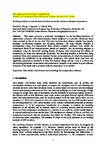Buckling analysis of cold-formed steel channel-section beams at elevated temperatures
| dc.contributor.author | Cheng, Shanshan | |
| dc.contributor.author | Li, Long-yuan | |
| dc.contributor.author | Kim, Boksun | |
| dc.date.accessioned | 2018-03-05T18:03:08Z | |
| dc.date.available | 2018-03-05T18:03:08Z | |
| dc.date.issued | 2015-01 | |
| dc.identifier.issn | 0143-974X | |
| dc.identifier.issn | 1873-5983 | |
| dc.identifier.uri | http://hdl.handle.net/10026.1/10963 | |
| dc.description.abstract |
This paper presents a numerical investigation on the buckling behaviour of plasterboard protected CFS channel-section beams subjected to uniformly distributed loads when exposed to fire on its one side. The work involves three phases, namely heat transfer analysis, pre-buckling analysis and buckling analysis. The heat transfer analysis is accomplished using two-dimensional finite element analysis methods, from which the temperature fields of the channel-section beams are obtained. The pre-buckling analysis is completed using the Bernoulli bending theory of beams with considering the effects of temperature on strain and mechanical properties. The buckling analysis is performed using combined finite strip analysis and classical Fourier series solutions, in which the mechanical properties are considered to be temperature dependent. The results show that there are significant temperature variations in web, fire exposed flange and lip. Also, it is found that the buckling behaviour of the beam with temperature variation in its section is quite different from that of the beam with a constant uniform temperature in its section. | |
| dc.format.extent | 74-80 | |
| dc.language | en | |
| dc.language.iso | en | |
| dc.publisher | Elsevier BV | |
| dc.subject | Thin-walled | |
| dc.subject | Cold-formed steel | |
| dc.subject | Buckling | |
| dc.subject | Fire | |
| dc.subject | Temperature | |
| dc.subject | Channel | |
| dc.title | Buckling analysis of cold-formed steel channel-section beams at elevated temperatures | |
| dc.type | journal-article | |
| dc.type | Journal Article | |
| plymouth.author-url | https://www.webofscience.com/api/gateway?GWVersion=2&SrcApp=PARTNER_APP&SrcAuth=LinksAMR&KeyUT=WOS:000346217300007&DestLinkType=FullRecord&DestApp=ALL_WOS&UsrCustomerID=11bb513d99f797142bcfeffcc58ea008 | |
| plymouth.volume | 104 | |
| plymouth.publication-status | Published | |
| plymouth.journal | Journal of Constructional Steel Research | |
| dc.identifier.doi | 10.1016/j.jcsr.2014.10.004 | |
| plymouth.organisational-group | /Plymouth | |
| plymouth.organisational-group | /Plymouth/Faculty of Science and Engineering | |
| plymouth.organisational-group | /Plymouth/Faculty of Science and Engineering/School of Engineering, Computing and Mathematics | |
| plymouth.organisational-group | /Plymouth/REF 2021 Researchers by UoA | |
| plymouth.organisational-group | /Plymouth/REF 2021 Researchers by UoA/UoA12 Engineering | |
| plymouth.organisational-group | /Plymouth/Research Groups | |
| plymouth.organisational-group | /Plymouth/Research Groups/Marine Institute | |
| plymouth.organisational-group | /Plymouth/Users by role | |
| plymouth.organisational-group | /Plymouth/Users by role/Academics | |
| dc.identifier.eissn | 1873-5983 | |
| dc.rights.embargoperiod | Not known | |
| rioxxterms.versionofrecord | 10.1016/j.jcsr.2014.10.004 | |
| rioxxterms.licenseref.uri | http://www.rioxx.net/licenses/all-rights-reserved | |
| rioxxterms.type | Journal Article/Review |


